World Class IT Support & Service
Real People. Right Now.
About Locknet® IT Services
From the first hello, the Locknet® team is dedicated to serving you and your needs.
Real People. Right Now.
From the first hello, the Locknet® team is dedicated to serving you and your needs.


With the increasing sophistication of cyberattacks and fraud schemes, traditional methods of fraud prevention, while valuable, often struggle to keep pace. That’s where artificial intelligence (AI) comes in. It’s a revolutionary tool that is rapidly transforming how financial institutions combat fraud. By leveraging AI for fraud detection, banks and other financial organizations can proactively identify suspicious activity, mitigate risks, and strengthen their overall security posture. Let’s take a closer look at how it works and the most recent trends.
Fraud costs the global economy billions of dollars each year, with financial institutions being prime targets. In fact, credit card fraud losses worldwide are expected to reach $43 billion by 2026. The complexity and scale of modern fraud make it challenging for manual processes or static, rule-based systems to keep up.
In an era where consumers demand fast, seamless transactions, AI utilizes machine learning (ML) algorithms and data analytics to detect anomalies and suspicious patterns - providing financial institutions both speed and security.
We’ll review the latest trends for using AI technologies for fraud detection in financial institutions.
One of the primary benefits of AI for fraud detection is its ability to process large volumes of data in real-time. AI-powered systems can continuously monitor transactions and identify any discrepancies or abnormal patterns that may indicate fraudulent activity.
For instance, AI algorithms can detect deviations in spending behavior, such as sudden large withdrawals or purchases in geographically distant locations. This real-time analysis enables financial institutions to flag suspicious transactions as they occur, allowing for immediate intervention.
AI-based systems can also integrate seamlessly with other technologies like blockchain, enhancing transparency and traceability across financial networks.
Machine learning models excel at anomaly detection, one of the most effective methods for spotting fraud. Unlike traditional systems that rely on fixed rules, ML algorithms can learn from historical and real-time data, evolving as new fraud tactics emerge.
These models can be trained on vast datasets of past fraudulent and legitimate transactions, enabling them to accurately distinguish between normal and abnormal activity. As ML models continue to learn from new data, they become more adept at identifying unusual patterns that might be overlooked by human analysts or rule-based systems. This ongoing learning process ensures that financial institutions stay ahead of fraudsters, even as their tactics change.
AI’s capabilities go beyond analyzing transaction data. Natural language processing (NLP) algorithms are being used to detect fraudulent communications in real-time. From analyzing phone conversations to scanning emails and chat messages, NLP can identify language patterns indicative of social engineering attempts, phishing schemes, or other fraud tactics.
Financial institutions can deploy NLP-based systems to monitor customer interactions and identify red flags early in the process, preventing incidents such as wire transfer fraud or account takeover before they occur. This technology is particularly useful in call centers or digital banking platforms where fraudulent actors may attempt to trick customer service representatives or clients.
Another cutting-edge AI-driven technology is behavioral biometrics, which analyzes patterns such as typing speed, mouse movements, and how users interact with their devices. AI can create unique behavioral profiles for individual users and continuously compare real-time interactions against these profiles.
If deviations occur, such as a user typing more slowly than usual or navigating through an online banking portal in an abnormal way, the system can flag the activity as suspicious and request additional authentication. Behavioral biometrics add an additional layer of security without hindering the user experience, making it a valuable tool in preventing identity theft and unauthorized account access.
Beyond just detecting fraud, AI plays a crucial role in preventing it. Predictive analytics, a subset of AI, enables financial institutions to forecast potential fraud based on historical data and behavioral trends. This proactive approach allows banks to adjust security measures before fraud occurs, rather than merely reacting to incidents after they’ve happened.
AI can be integrated into a broader risk management framework, where it helps institutions assess their overall exposure to fraud and develop targeted mitigation strategies. Whether it’s flagging high-risk customers or identifying gaps in their current security systems, AI empowers institutions to address fraud risks comprehensively.
Humans simply cannot keep up with the speed and thoroughness of data interrogation that AI and ML can deliver today. As a result, we need to embrace and team up with such technologies. And many already are. A study earlier this year by the Association of Certified Fraud Examiners revealed that 17% of organizations already leverage AI and ML to detect and prevent fraud, and 26% of organizations are actively planning to adopt fraud detection AI or ML in the next two years. On top of that, technology providers are now heavily investing in developing practical AI-driven solutions to tackle payment fraud.
Here are a few recent real-world examples of financial institutions successfully utilizing generative AI in fraud detection.
At the intersection of finance and technology, institutions that leverage AI for fraud detection stand to gain a significant competitive advantage. Not only does AI enhance the accuracy of fraud detection, but it also enables faster response times and an improved customer experience.
Locknet is committed to helping financial institutions navigate the complexities of AI adoption. Whether through education about AI due diligence or strategic technology consulting, we share our expertise to safeguard our clients against cybercrime. By staying at the forefront of cybersecurity trends and AI technology, we help our clients remain secure, compliant, and prepared for the future of financial fraud prevention.
Cybersecurity

Onalaska, WI Waterloo, IA Wausau, WI Eau Claire, WI Burnsville, MN
You are now leaving locknetmanagedit.com. Please check the privacy policy of the site you are visiting.